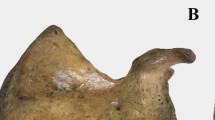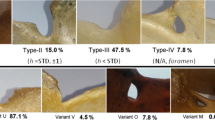Abstract
Introduction
The size and shape of the suprascapular notch (SSN) may be a factor in suprascapular nerve entrapment. The aim of the study was to determine the variation of the SSN of 86 scapulae in the Polish people.
Methods
A total of 86 human scapulae were included in the study. Three measurements were defined and collected for every SSN: maximal depth (MD), superior (STD) and middle (MTD) transverse diameters. The measurements of the SSN were taken using two complementary methods: classical osteometry and a new one based on the analysis of digital photographic documentation of the SSN taken using MultiScanBase v.14.02 software.
Results
The analysis allowed determining five types of SSN. Type I has a longer maximal depth than superior transverse diameter (24.4%). Type II has equal MD, STD and MTD (2.3%). Type III has a superior transverse diameter longer than the maximal depth (54.7%). Type IV was a bony foramen (7%). Type V has a discrete notch (11.6%). Types I and III were divided into three subtypes: A (MTD was longer than STD), B (equal, MTD = STD) and C (inversely, MTD < STD). Superior transverse suprascapular ligament was completely and partially ossified in 7 and 23.3%, respectively.
Conclusion
The presented quantitative classification of the SSN is simple and based on specific geometrical parameters that clearly distinguish five structural types and could be used in the further investigation in computer tomography or ultrasonography. The ossification of the superior transverse scapular ligament (STSL) in the study of the Polish people was similar to that described in Germany, France and Italy.







Similar content being viewed by others
References
Antonoiou J, Tae SK, Wiliams GR, Bird S, Ramsey MJ, Iannotti JP (2001) Suprascapular neuropathy. Variability in the diagnosis, treatment, and outcome. Clin Orthop Relat Res 386:131–138
Barwood SA, Burkhart SS, Lo IK (2007) Arthroscopic suprascapular nerve release at the suprascapular notch in a cadaveric model: an anatomic approach. Arthroscopy 23:221–225
Bayramoglu A, Demiryurek D, Tuccar E, Erbil M, Aldur MM, Tetik O, Doral MN (2003) Variations in anatomy at the suprascapular notch possibly causing suprascapular nerve entrapment: an anatomical study. Knee Surg Sport Trauma Arthrosc 11:393–398
Bhatia DN, de Beer JF, van Rooyen KS, du Toit DF (2006) Arthroscopic suprascapular nerve decompression at the suprascapular notch. Arthroscopy 22:1009–1013
Brothwell DR (1981) Digging up bones: the examination, treatment and study of human skeletal remains. Oxford University Press, Oxford
Cohen SB, Dnes DM, Moorman CT (1997) Familial calcification of the superior transverse scapula ligament causing neuropathy. Clin Orthop Relat Res 334:131–135
Cummins CA, Messer TM, Nuber GW (2000) Suprascapular Nerve Entrapment. J Bone Joint Surg 82:415–424
Dunkelgrun M, Iesaka K, Park SS, Kummer FJ, Zuckkerman JD (2003) Interobserver reliability and intraobserver reproducibility in suprascapular notch typing. Bull Hosp Joint Dis 61:118–122
Duparc F, Coquerel D, Ozeel J, Noyon M, Gerometta A, Ch Michot (2010) Anatomical basis of the suprascapular nerve entrapment and clinical relevance of the supraspinatus fascia. Surg Radiol Anat 32:277–284
Edeland HG, Zachrisson BE (1975) Fracture of the scapular notch associated with lesion of the suprascapular nerve. Acta Orthop Scand 46:758–763
Edelson JG (1995) Bony bridges and other variations of the suprascapular notch. J Bone Joint Surg Br 77:505–506
Ghodadra N, Nho S, Verma N, Reiff S, Piasecki D, Provencher M, Romeo A (2009) Arthroscopic decompression of the suprascapular nerve at the spinoglenoid notch and suprascapular notch through the subacromial space. Arthroscopy 25:439–445
Gosk J, Urban M, Rutowski R (2007) Entrapment of the suprascapular nerve: anatomy, etiologic diagnosis, treatment. Traumatol Rehabil 9:68–74
Harmon D, Hearty C (2008) Diameter of suprascapular nerve in the suprascapular notch. Pain Phys 11:263–264
Holzgraefe M, Kukowski B, Eggert S (1994) Prevalence of latent and manifest suprascapular neuropathy in high-performance volleyball players. Br J Sport Med 28:177–179
Hrdicka A (1942) The adult scapula: visual observations. Am J Phys Anthropol 29:73–94
Hrdicka A (1942) The adult scapula: additional observations and measurements. Am J Phys Anthropol 29:363–415
Khan MA (2006) Complete ossification of the superior transverse scapular ligament in an Indian male adult. Int J Morphol 24:195–196
Kopell HP, Thompson WAL (1959) Pain and the frozen shoulder. Surg Gynecol Obstet 109:92–96
Lafosse L, Tomasi A, Corbett S, Baier G, Willems K, Gobezie R (2007) Arthroscopic release of suprascapular nerve entrapment at the suprascapular notch: technique and preliminary results. Arthroscopy 23:34–42
Loth E (1955) Odmiany mammalogeniczne w budowie człowieka. Przegl Antrop 21:258–280
Loth E (1957) Cechy eugeniczne w budowie człowieka. Przegl Antrop 23:259–312
Malinowski A, Wolański N (1988) Metody badań w biologii człowieka. Wybór metod antropologicznych. PWN, Warszawa
Malinowski A, Bożiłow W (1997) Podstawy antropometrii (metody, techniki, normy). PWN, Łodź
Moore KL, Dalley AF, Agur AM (2010) Clinical oriented anatomy, 6th edn. Lippincott Williams & Wilkins, Philadelphia
Moriggl B (1997) Moglichkeiten und Grenzen des Sonographie osteofibroser Kanale im Schulterbereich. Grundlagen Ann Anat 179:355–373
Natsis K, Totlis T, Tsikaras P, Appell HJ, Skandalakis P, Koebke J (2007) Proposal for classification of the suprascapular notch: a study on 423 dried scapulas. Clin Anat 20:135–139
Ofusori D, Ude R, Okwuonu Ch, Adesanya O (2008) Complete absence of the suprascapular notch in a Nigerian scapula: a possible cause of suprascapular nerve entrapment. Int J Should Surg 2:85–86
Olivier G (1960) Pratique anthropologique. Le scapulum. Vigot Freres, Paris, pp 194–201
Prescher A (2000) Anatomical basics, variations, and degenerative changes of the shoulder joint and shoulder girdle. Eur J Radiol 35:88–102
Rengachary SS, Burr D, Lucas S, Hassanein KM, Mohn MP, Matzke H (1979) Suprascapular entrapment neuropathy: a clinical, anatomical, and comparative study. Part 1: clinical study. Neurosurgery 5:441–446
Rengachary SS, Burr D, Lucas S, Hassanein KM, Mohn MP, Matzke H (1979) Suprascapular entrapment neuropathy: a clinical, anatomical, and comparative study. Part 2: anatomical study. Neurosurgery 5:447–451
Schroder HP, Kuiper SD, Botte MJ (2001) Osseous anatomy of the scapula. Clin Orthop Relat Res 383:131–139
Ticker JB, Djurasovic M, Strauch RJ, April EW, Pollock RG, Flatow EL, Bigliani LU (1998) The incidence of ganglion cysts and other variations in anatomy along the course of the suprascapular nerve. J Should Elb Surg 7:472–478
Tubbs RS, Smyth MD, Salter G, Oakes WJ (2003) Anomalous traversement of the suprascapular artery through the suprascapular notch: a possible mechanism for undiagnosed shoulder pain? Med Sci Monit 9:116–119
Urguden M, Ozdemir H, Donmez B, Bilbasar H, Oguz N (2004) Is there any effect of suprascapular notch type in iatrogenic suprascapular nerve lesions? An anatomical study. Knee Surg Sports Traumatol Arthrosc 12:241–245
Vallois HV (1925) L’os acromial dans les races humaines. L’ Anthropologie, Paris 35:977–1022
Vallois HV (1926) Variations de la cavite glenoide de L’omoplate. Soc Biol Comptes Rendus Hebdomadaires Seances et memoires 94:559–560
Vastamaki M, Goransson H (1993) Suprascapular nerve entrapment. Clin Orthop Relat Res 297:135–143
Yücesoy C, Akkaya T, Özel O, Cömert A, Tüccar E, Bedirli N, Ünlü E, Hekimoflu B, Gümüo H (2009) Ultrasonographic evaluation and morphometric measurements of the suprascapular notch. Surg Radiol Anat 31:409–414
Zehetgruber H, Noske H, Lang T, Wurnig C (2002) Suprascapular nerve entrapment; a meta-analysis. Int Orthop 26:339–343
Conflict of interest
The authors declare that they have no conflict of interest.
Author information
Authors and Affiliations
Corresponding author
Rights and permissions
About this article
Cite this article
Polguj, M., Jędrzejewski, K., Podgórski, M. et al. Morphometric study of the suprascapular notch: proposal of classification. Surg Radiol Anat 33, 781–787 (2011). https://doi.org/10.1007/s00276-011-0821-y
Received:
Accepted:
Published:
Issue Date:
DOI: https://doi.org/10.1007/s00276-011-0821-y




